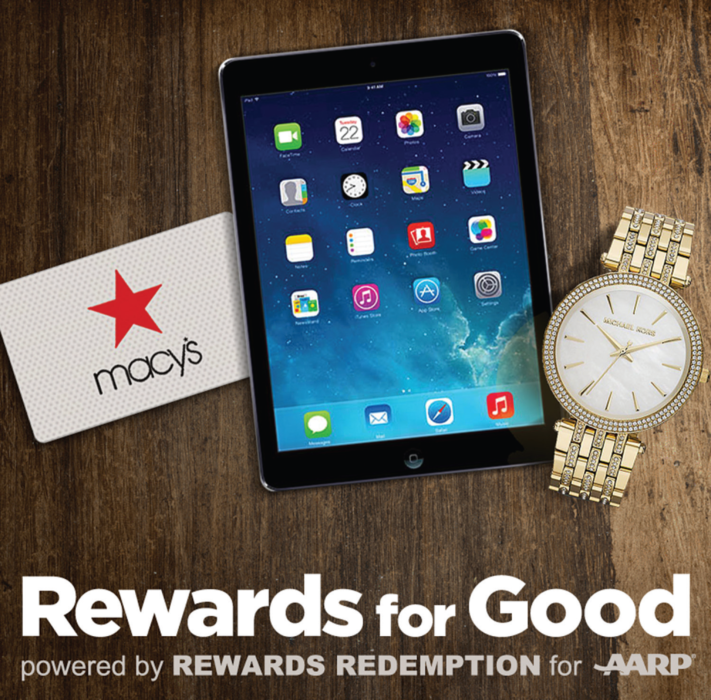| Adults can participate in the Rewards for Good program to earn points, which can be redeemed for rewards, by interacting on AARP’s website. |
Loyalty, for many marketers, is defined by how much consumers spend over time. For marketers at AARP, however, loyalty is determined by how much they engage. With an estimated 11.5 million people visiting its site each month, AARP sees a lot of interaction with its brand. This past February the nonprofit organization for mature adults decided to reward visitors for their engagement by launching on site its first-ever digital loyalty program, Rewards for Good.
“[Members’] engagement and their time is an investment on their part,” says Nataki Edwards, VP of digital strategy and operations for AARP. “Why shouldn’t they be rewarded?”
How it works
The loyalty program, Edwards says, has two main goals: to promote AARP’s social mission—which is to improve the quality of life for those 50 and older—and to drive site log-ins and registrations. Adults of all ages can participate in the Rewards for Good program by visiting AARP.org, enrolling, and then taking part in qualifying activities that she says align with its mission and can enhance the lives of its 50-and-older target audience. For example, using a brain fitness quiz, a retirement calculator, and a prescription comparison tool can boost awareness about mental acuity, retirement planning, and prescription options, respectively. “It’s almost like putting the cheese sauce on the broccoli,” Edwards says. “You want to eat your vegetables, but you make it attractive.”
After completing an activity, participants receive points. While some activities reward users every time they engage—such as AARP’s job search tool—other interactions—like the quizzes—only compensate them once. This model prevents users from gaming the system and promotes continued education and engagement, Edwards says. Once users earn enough points, they can redeem the points for rewards—such as gift cards, handbags, and electronics—or use them to bid for prizes in eBay-style auctions.
In terms of AARP’s goal of driving site log-ins and registrations, the more the organization knows about users, the better the experience it can provide. User sign-ins, for example, turn anonymous visitors into recognized users, which helps AARP’s marketing team create more relevant content by tracking on-site behavior, Edwards explains. For example, if users frequently engage with the site’s lifestyle content, then AARP will use similar content on its website and in its emails. If they don’t respond to a topic or approach, the brand will change up its tactics.
“It’s a constant learning based on what the user is explicitly and implicitly telling us,” Edwards says. She adds that the Rewards for Good program drives page views for the brand and provides value to users—making it a win-win for both.
A maturing program
AARP started planning the Rewards for Good program about 18 months prior to its February launch, and spent about six to 12 months choosing the right partners, tools, and hooks to draw in users, promote loyalty, and encourage membership. One hook, for example, is that AARP members get 50% more points than nonmembers for the same activities.
AARP focused much of its time and attention on finding the right balance between true engagement and valuable rewards—a combination that Edwards says encourages frequent interaction and turns the program into a routine part of users’ lives. “The most successful loyalty programs are those that reward you for the things that you’re going to do anyway,” she says.
Creating a seamless user experience is another benefit of the loyalty program’s lengthy rollout. However, Edwards considers AARP’s diligence in unifying the user experience—such as creating a single sign-in when redeeming rewards—to be time well spent.
“Making sure that the systems are talking, the databases are talking, and the user is always treated as one person—that takes time and effort,” she says.
Golden results
Nearly one million people have participated in the Rewards for Good program since its launch. AARP continues to promote the program through paid and organic search, banner ads, and email campaigns. The organization is also conducting focus groups and surveys to see if the program is resonating with its target audience. Perhaps a less tangible win is that Rewards for Good fights against stereotypes suggesting that older generations aren’t digitally savvy.
“It’s impressive how engaged our users have been with our digital offerings in general,” Edwards says. “If you think about what they’re doing overall on the Internet, it’s really pretty impressive.”







